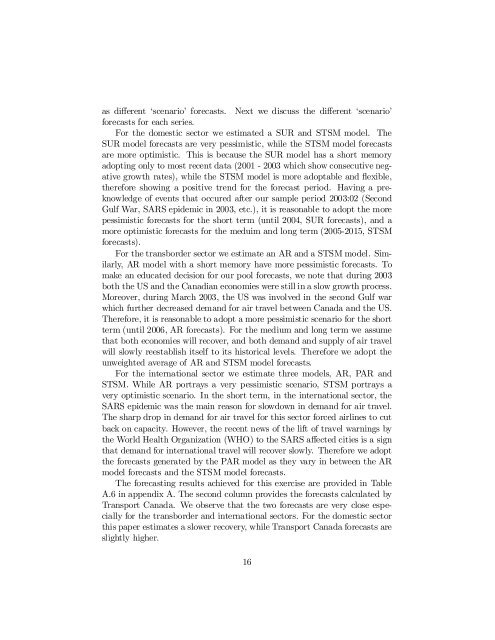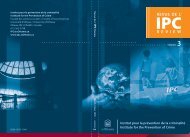0306E - Faculty of Social Sciences - Université d'Ottawa
0306E - Faculty of Social Sciences - Université d'Ottawa
0306E - Faculty of Social Sciences - Université d'Ottawa
You also want an ePaper? Increase the reach of your titles
YUMPU automatically turns print PDFs into web optimized ePapers that Google loves.
as di¤erent ‘scenario’ forecasts. Next we discuss the di¤erent ‘scenario’<br />
forecasts for each series.<br />
For the domestic sector we estimated a SUR and STSM model. The<br />
SUR model forecasts are very pessimistic, while the STSM model forecasts<br />
are more optimistic. This is because the SUR model has a short memory<br />
adopting only to most recent data (2001 - 2003 which show consecutive negative<br />
growth rates), while the STSM model is more adoptable and ‡exible,<br />
therefore showing a positive trend for the forecast period. Having a preknowledge<br />
<strong>of</strong> events that occured after our sample period 2003:02 (Second<br />
Gulf War, SARS epidemic in 2003, etc.), it is reasonable to adopt the more<br />
pessimistic forecasts for the short term (until 2004, SUR forecasts), and a<br />
more optimistic forecasts for the meduim and long term (2005-2015, STSM<br />
forecasts).<br />
For the transborder sector we estimate an AR and a STSM model. Similarly,<br />
AR model with a short memory have more pessimistic forecasts. To<br />
make an educated decision for our pool forecasts, we note that during 2003<br />
both the US and the Canadian economies were still in a slow growth process.<br />
Moreover, during March 2003, the US was involved in the second Gulf war<br />
which further decreased demand for air travel between Canada and the US.<br />
Therefore, it is reasonable to adopt a more pessimistic scenario for the short<br />
term (until 2006, AR forecasts). For the medium and long term we assume<br />
that both economies will recover, and both demand and supply <strong>of</strong> air travel<br />
will slowly reestablish itself to its historical levels. Therefore we adopt the<br />
unweighted average <strong>of</strong> AR and STSM model forecasts.<br />
For the international sector we estimate three models, AR, PAR and<br />
STSM. While AR portrays a very pessimistic scenario, STSM portrays a<br />
very optimistic scenario. In the short term, in the international sector, the<br />
SARS epidemic was the main reason for slowdown in demand for air travel.<br />
The sharp drop in demand for air travel for this sector forced airlines to cut<br />
back on capacity. However, the recent news <strong>of</strong> the lift <strong>of</strong> travel warnings by<br />
the World Health Organization (WHO) to the SARS a¤ected cities is a sign<br />
that demand for international travel will recover slowly. Therefore we adopt<br />
the forecasts generated by the PAR model as they vary in between the AR<br />
model forecasts and the STSM model forecasts.<br />
The forecasting results achieved for this exercise are provided in Table<br />
A.6 in appendix A. The second column provides the forecasts calculated by<br />
Transport Canada. We observe that the two forecasts are very close especially<br />
for the transborder and international sectors. For the domestic sector<br />
this paper estimates a slower recovery, while Transport Canada forecasts are<br />
slightly higher.<br />
16
















